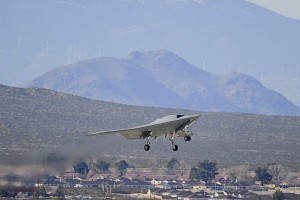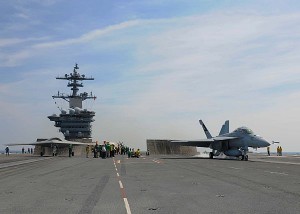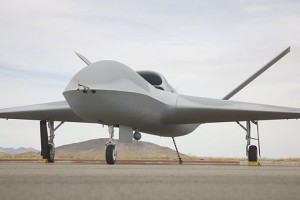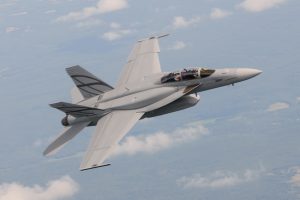 Two things inform the upcoming MQ-25 Stingray opportunity: The first is that Northrop Grumman will be hard to beat, and, second, airframe innovation should take a distant backseat to the work needed to harden and prove-out the electronic “back-end” of carrier-based UAVs.
Two things inform the upcoming MQ-25 Stingray opportunity: The first is that Northrop Grumman will be hard to beat, and, second, airframe innovation should take a distant backseat to the work needed to harden and prove-out the electronic “back-end” of carrier-based UAVs.
I had a chance to discuss all this with the San Diego Business Journal last week (the article is behind a paywall, here).
The MQ-25 Stingray should be a low-end, bare-bones platform, focused on three things: 1) Integrating UAVs into carrier operations; 2) Demonstrating operational feasibility in the field; and 3) Testing advanced operational concepts. If done right, the Navy is going to lose some of these vehicles, so they should plan accordingly and buy the cheap model.
Sure, any new and exotic airframe is hard to resist, but if the Navy is going to invest a single shekel in pushing the limits of already well-proven aerodynamic principles to obtain anything other than fewer launch/landing cycles through greater payload/endurance, then, well, they’re doing it wrong.
For this program, the U.S. Navy needs to be laser-focused on getting the computer, flight AI and electrical systems optimized for carrier operations, demonstrate that these things are sailor-proof and figure out an operational path for these vehicles in what will be a rather sporty electromagnetic environment.
Everything else comes second.
But Boeing, Lockheed and General Atomics have gotta beat Northrop Grumman first.
 “Northrop Grumman is the contractor to beat”:
“Northrop Grumman is the contractor to beat”:
So as I discussed the MQ-25 Stingray competition with Brad Graves, defense business reporter at the underestimated San Diego Business Weekly–a paper which offers some really great reporting on the booming Southern California defense industry–I detailed Northrop Grumman’s advantages.
As most of my readers know, Northrop Grumman received $635.8 million dollars to build and demonstrate the X-47B, an unmanned platform that ultimately operated off a number of aircraft carriers and completed some air-to-air refueling evolutions. Couple that superior performance with the big B-21 win, Northrop Grumman’s Global Hawk/Triton, their two flavors of Fire Scout, and their hefty joint R&D investment in DARPA’s emerging monster Tactically Exploited Reconnaissance Node (TERN) program, Northrop has a huge lead in carrier/ship-based UAV systems operation/integration as well as a superior handle on maritime ISR requirements.
Even if Northrop Grumman has a had some rocky times managing schedule and price, the company is, ah, “well positioned to win.”
As I told Brad:
“If I’m chasing Northrop Grumman, I may have to take some risks,” said Hooper, “How do you compete with a company that has done a good job of advancing the Navy’s unmanned aviation initiatives?”
I can hear the “spread-the-wealth” detractors now–sure, Northrop has it’s hands full on the B-21 strategic bomber, etc., etc.. Aside from the fact that Northrop won because it’s following the TERN example–putting skin in the game by putting in a lot of company-funded R&D into the mix, there’s not a lot to go on here. But, “spread the wealth” does come into play here–Lockheed has a really heavy lift ahead if their bid team believes the Navy will hand over a potentially large carrier airframe project over to the contractor building the multi-billion-dollar F-35B and F-35C aircraft.
 General Atomics has a good UAV record, but it also has credibility problems in regards to carrier aviation. From the outside, General Atomics is kind of the “Eastern Shipbuilding” of this competition. It’s a scrappy company, trying to break into an entirely new “carrier aviation” field, but, I don’t see General Atomics advancing within the carrier aviation community until the Ford Class EMALS/Advanced Arresting Gear systems are operational and reliable.
General Atomics has a good UAV record, but it also has credibility problems in regards to carrier aviation. From the outside, General Atomics is kind of the “Eastern Shipbuilding” of this competition. It’s a scrappy company, trying to break into an entirely new “carrier aviation” field, but, I don’t see General Atomics advancing within the carrier aviation community until the Ford Class EMALS/Advanced Arresting Gear systems are operational and reliable.
That leaves Boeing as the last competitor standing, the poor old aerospace veteran that’s looking at the end of the F-18 line, and possibly an exit from defense aerospace altogether.
 Boeing’s Case:
Boeing’s Case:
Outside of a classified wildcard–who knows what interesting stuff any of these companies have flying–I still think the field is immature enough that the electronic “back-end” of the UAV business case needs a lot more work. So, rather than trying to taylor a pricey, exotic and likely highly classified platform to fit the modest Stingray requirements, it may be better to go low-end and use a variant of an existing platform.
Look, the Navy must realize that Stingrays are going to crash pretty regularly as the AI struggles to understand fog, storms, sea spray, EW, rolls, and all those delightful operational intangibles that earn carrier aviators nice leather chair-appointed ready rooms. Any loss stings, but I’d rather lose something pretty cheap and relatively pedestrian (like an F-18 airframe) than lose something horribly pricey that’s derived from some classified “Beast of Kandahar” RQ-170-type program.
Let’s go for cheap and functional and incrementally invest in a really, really strong UAV back-end.
This is where Boeing might shine. If low-end platforms are viable options, then there’s room in this MQ-25 Stingray development process to take Boeing’s existing manned platform, de-scope it, and convert it into a flying gas tank. Building a tanker around a bare-bones $35 million dollar F-18 airframe (assuming it is feasible re-crafting the platform for gas-hauling rather than dogfighting) would solve a lot of pressing industrial base problems, and it would quickly get the fleet a functional UAV that we already know is capable of playing a little bit in the ISR/combat-lite world (the photo above is from one of the first flights of an F-18 with conformal fuel tanks).
It’s not too expensive. CNAS’ Jerry Hendrix–quoted in the same article–ball-parked the per-unit cost as somewhere between $50 to $150 million, so a repurposed Hornet might work.
We know the F-18 can go unmanned and, as such, the platform is already integrated into the carrier air wing. The F-18 was the X-47B risk reduction platform, demonstrating unmanned carrier landing software. And we also know that Boeing has the QF-16 program, which turns F-16s into autonomous flyers–offering a perfect place for the company to quietly work through the challenge of autonomy on a high-end platform.
It wouldn’t be a big and expensive lift integrating an F-18-derived platform into the carrier air wing or maintenance shops, either–and if Boeing could demonstrate a cost-effective path for converting older platforms into a somewhat disposable platform for refueling these things, then, goodness, that’d be a hard platform for Northrop Grumman to beat (unless, of course, Northrop already has a platform that offers lots of capacity in a high-endurance package).
Conclusion:
Right now, this feels like a Northrop Grumman/Boeing fight, with General Atomics the wild-card and Lockheed bringing up in the rear. Of course, it’ll all depend upon how the RFP is written, and I wish every person involved in this fascinating competition the best of luck in writing the next chapter in carrier aviation.
But what worries me is that, given the original “high-end” origin of a lot of likely Stingray proposals–advanced by vendors who chased the Stingray opportunity down from the program’s higher-end beginnings as a strike platform–are going to be awesome platforms that do little more than detract from the mission at hand–getting an operational UAV aboard a carrier and demonstrating that sailors can operate that platform day in and day out. But, ultimately, an entire carrier is out of action if the tankers can’t fly. They’ve gotta work every day.

{ 1 comment… read it below or add one }
Leave a comment in disqus